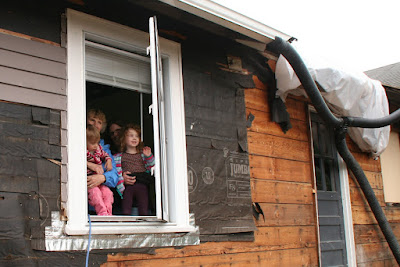 |
| Getting the forms built in preparation for the pour of concrete for the new basement walls. |
 |
| As you can see, the forms are pretty massive. |
 |
| We never found out for sure, but we think this guy is spraying non-stick liquid on the forms and form hardware so that they'll come off easily after the pour. |
 |
| In addition to pouring the walls for the new basement, a shear wall foundation in the existing basement had to be reinforced.. |
 |
| Rebar in one of the nine basement footings |
 |
| Here come the concrete rigs--the pump truck and the cement mixer, one of two required to do the pour. |
 |
| Getting ready to begin the pour, as Sandy, Susan, Maya, and Zoe look on. |
 |
| peanut gallery |
 |
| It was a fascinating process. |
 |
| More of the peanut gallery--two sparrows, very curious about the proceedings. |
 |
| Steve Gregory makes sure the concrete ends up where it's supposed to go. |
 |
| additional footing in the existing basement space |
 |
| Ditto |
 |
| Ditto |
 |
| The guys were really happy when this part of the job was done. |
 |
| beginning to pour the walls of the new basement |
 |
| The physical strength involved in a job like this is really amazing! |
 |
| more of the pour |
 |
| Granddaughter Maya spent the whole time watching the pour with us. She learned and retained the name of every single worker on the project and had a keen eye on what was going on. |
 |
| Can I come and watch the next pour, Grandma? |
 |
| the pour continues |
 |
| getting toward the top |
 |
| BBB site manager, Dylan, makes sure things have gone according to plan. |
 |
| Dylan has a good eye for detail and doesn't leave anything to chance. The elevator foundation pour was especially tricky, and Dylan carefully checked the engineering plans as the pour proceeded. |
 |
| Finishing up. The square in the lower right corner of this photo is the base of the elevator shaft. |
 |
| finishing the pour around the elevator encasement |
 |
| ditto |
 |
| new shear wall foundation in the basement crawl space |
 |
| Note the perforated pipe and the water stop drainage material which will help ensure that we have a dry basement from now on. |
 |
| Dylan applies an asphalt substance as an additional guard against water seepage. |
 |
| asphalt and "delta drain" on all sides of the structure |
 |
| Additional pipe and hose for the drainage system have arrived. |
 |
| We're off on vacation for the next 12 days, so there won't be a posting next week. We'll resume when we return. |











No comments:
Post a Comment